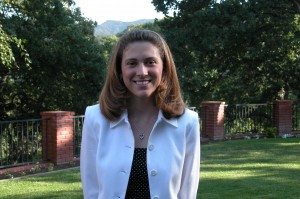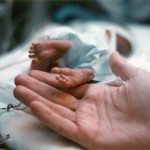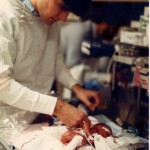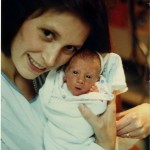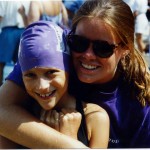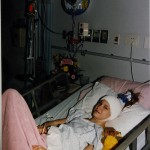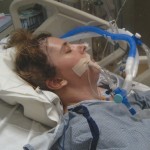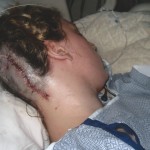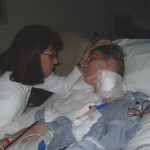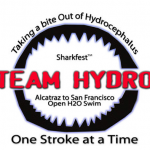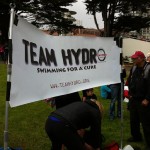Behind Team Hydro–Kate’s Story
Team Hydro was founded when the brothers of a young Hydrocephalus patient became so frustrated by the outdated treatments available for patient’s with the condition, they decided to take action! Having watched their sweet sister endure hundreds of surgeries and hospitalizations in an attempt to stay alive, the boys were desperate to find a way to promote new research. The brothers, along with two wonderful friends, first swam from Alcatraz to San Francisco under the Team Hydro Banner in 2008, raising much-needed awareness and over $10,000 in funds for Hydrocephalus Research. At the time of the first swim, Kate had just spent over a month in ICU, once again fighting for her life–she was thrilled to able to watch the event from the balcony of a nearby hotel room. Kate was so honored and excited by the Team Hydro effort! It gave her great hope that as a result of new research, one day a cure would be found, and others would not have to suffer as she did. Unfortunately, the inadequate treatments available for hydrocephalus failed her too soon–two years later, Kate passed from complications of her treatment. Below is the story of how Hydrocephalus affected her life:
Kate Finlayson: Daughter, Sister, Swimmer, Friend
Kate was born 3 and 1/2 months early. Weighing barely 2 pounds, Kate was very tiny and very sick. On her third day of life, complications of her treatment caused her to suffer a severe brain hemorrhage. This hemorrhage, caused the brain to develop Hydrocephalus, and Kate was shunted soon after. (A “shunt” is a catheter and valve system placed in the brain, to regulate the cerebral spinal fluid made there–without a working shunt, most persons with hydrocephalus will suffer coma and die.)
The brain bleed itself was so severe that doctors thought Kate would likely die, or at least, never be able to live any sort of “normal” life. But Kate was fortunate to survive to do better than expected, and her early years were marked by only one shunt revision at age two. Despite the hydrocephalus, Kate was fortunate to spend many fun, happy days as a young child. Kate did have some learning and physical disabilities, but her family worked with her every day to help her develop as much as possible. One of Kate’s complications was hemiplegia, (where one side of her body did not work as well as the other), and this led her parents to help her become involved in swimming, a sport which required her to use both sides of her body equally.
Kate loved the water! And while at first, her hemiplegia caused her to move in the water like a boat with only one oar (awkwardly around in circles), over time, her right side became stronger and eventually, Kate developed into a remarkable (even record-breaking) swimmer! Kate’s perseverance paid off in the classroom as well, and while Kate was slower than her peers when learning to read and write, with practice and devotion, those skills became passions as well. Kate enjoyed school, sports, and many other activities, and, as a result, her elementary years were also filled with many happy, fun, and adventurous times with family and friends.
But when Kate turned 10, she began having debilitating headaches. A trip to the neurosurgeon found her shunt not working properly. When the Surgeon went to remove the shunt (which had corroded and failed), Kate unfortunately suffered another brain hemorrhage. This hemorrhage caused her to develop another point of blockage in her brain, and so Kate now needed two shunt catheters in her brain to survive.
A second shunt was placed, but this caused the fluid in her brain to become over-drained, (a condition which also causes severe headaches and mental decline). Another surgery was needed to implant a different valve to regulate the fluid at an appropriate level. All seemed to have gone well at first, but then Kate developed a shunt infection from the surgery. This infection caused Kate’s brain to change further, and made her case of hydrocephalus a very difficult one to manage.
Kate’s shunts continued to fail. More infections followed, as did a steady stream of shunt revision surgeries. Over the next decade Kate would endure well over 100 surgeries in an attempt to treat her condition. During this time Kate lived in daily pain from the shunt either draining too much fluid, or not enough (both conditions are extremely painful and if untreated, lead to coma and death). Spending much of her life in the hospital, or recovering from brain surgery, Kate was forced to drop out of most social and sporting activities (including the sport of swimming she loved so much), as well as to complete high school via independent study. Kate worked very hard, and despite her declining health (which caused her to miss attending proms, sporting events, clubs, etc) Kate grad
During her teenage years Kate noticed that most people had never heard of hydrocephalus, and didn’t know how to respond to her diagnosis. People often became quite uncomfortable learning she had a problem affecting her brain–some so uncomfortable they no longer wanted to be friends. Kate tried to be a positive example and show friends and strangers alike, that people with hydrocephalus are “regular people, with just a few extra challenges to face”. But there is no questions that Kate, like many other people with hydrocephalus, often faced isolation due to the lack of awareness and chronic nature of this incurable condition. (Watching Kate suffer stigma and prejudice as a result of her hydrocephalus, prompted and continues to fuel Team Hydro’s awareness efforts.)
Shunt complications continued to plague Kate into her 20’s, as did more surgeries, strokes, and shunt infections. In the end, Kate needed 5 separate catheters in her brain to keep her shunted adequately. Kate spent the last year and a half of her life in a neurosurgical ICU subjected to dozens and dozens and dozens of more emergency shunt revisions. During this time, she lost most of her vision, developed terrible muscle spasms and tremors (similar to those of severe parkinson’s disease), and the skin on her head became more fragile than tissue paper from being opened surgically so many times. Though Kate also lost many of her physical skills as a result of treatment complications, she remained a positive example of hope, courage and love. She worked hard every day to region skills lost due to strokes, and never stopped caring for others–even in the hospital, she included making care packages for earthquake victims as part of her therapy.
Realizing that she would likely never recover from complications caused by her treatment, Kate inspired her family and medical staff by finding satisfaction in the knowledge that during her long and complicated illness, doctors were able to learn much about the way the brain works. Her case disproved some former theories regarding the brain’s physiology, and Kate took pleasure in thinking that, as a result of her case, perhaps one day others might be able to be treated for Hydrocephalus more successfully.
She was also thrilled at the advent of Team Hydro, (founded by her brothers as a response to their frustration and feelings of helplessness regarding their sister’s incurable and painful illness), and loved that others were using swimming–the sport she loved so much–as a means to raise funds for hydrocephalus. It was Kate’s dream that one day, no more people would need to suffer and die from this difficult condition.
Kate passed at the age of 26.
Her family is so grateful to each and every Team Hydro Swimmer and Supporter for helping to further Kate’s dream of researchers one day finding a cure for Hydrocephalus! Thank you for supporting Team Hydro and Hydrocephalus Research!
- love conquers all…
